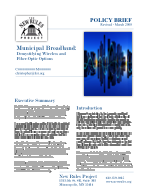![]() The United States, birthplace to the Internet, now lags in access to it.
The United States, birthplace to the Internet, now lags in access to it.
Countriesin Asia and Europe now have faster and cheaper connections, allowing their businesses to communicate more effectively, operate on smaller budgets, and develop applications that are useless over our slower speeds. Several Minnesota cities are regaining the edge with investments in publicly owned, citywide fiber-optic networks.
Businesses,schools, police departments, government agencies and residents all need fast network connections to compete, provide services, educate and entertain. Given all this demand in every community, common sense says the market should already have many suppliers competing for customers.
Marketsare more complicated than that. Building a network to offer broadband takes a massive initial investment. If a business attempted to build one, Comcast and Qwest could temporarily lower their prices to starve any newcomers for customers. Locally, we face a noncompetitive market where nearly everyone has access to cable for Internet access and a majority can choose between that and slightly slower DSL.
MinneapolisWireless offers its citizens another choice, but the speeds are comparable. These connections once offered the fastest speeds imaginable to a world primarily of text and static images. Times have changed. Standard connections barely allow poor-quality video phone chats. Employees attempting to work from home can easily access e-mail, but Advertisement uploading large files takes too long.
Asif the comparably slower speeds were not bad enough, we actually pay more for them. Minnesota businesses have to pay thousands each month for the same speeds that would cost hundreds in both densely populated Japan and considerably less dense Sweden.
Monticello,a small community just this side of St. Cloud, is taking advantage of our comparatively slow speeds. Recognizing the competitive advantage of fast networks, Monticello is investing in a fiber-optic network that will offer unparalleled speeds in the region.
Cities that have moved ahead are reaping the fruits of their efforts.
CedarFalls, Iowa, invested in a fast network years ago and has lured many new businesses to its rapidly growing business park. New construction in Cedar Falls is booming while its neighbor, Waterloo, has flat-lined.
St. Paul is studying an incremental approach with a different philosophy.
Thecity is considering partnerships with schools, the county and state government to build a network that would handle all its communication needs and could later be expanded to reach every home and business in the city. However, the city would not provide services on the network.
St.Paul would own the network but allow any service provider to use it on equal terms. This "common carrier" arrangement is how we have long operated roads. The government finances the roads, leaving UPS free to compete with FedEx and DHL on equal terms.
We stand at a unique time. Around the world, the fastest connections are wired with fiber optic cables. A single fiber strand can carry phone conversations, thousands of television channels and still have the capacity to offer Internet access at speeds impossible to reach over DSL or cable modems. The question is: Who will own that strand?
Citiesmust treat fiber networks – the roads of the digital age – as essential infrastructure. Publicly owned common-carrier networks create a competitive environment the cable and phone companies fear.
Theyhave long used the high cost of network construction to fend off competitors and are not used to competing on customer service.
Unsurprisingly, they are waging war on publicly owned networks with lawsuits and false claims.
Theirfirst criticism is to claim that tax money should not be used to finance the networks. But many cities, Monticello included, are already committed to building the networks without taxpayer support. Private investors are lining up to help finance fiber projects because they know it is a solid investment.
Burlington, a city of 39,000 in Vermont, is nearly finished with its network. Before the last fiber is connected, it will already be generating more income than it needs for operations and debt service.
That extra money will go into the general fund, creating a new revenue stream for the city.
Youmay hear many arguments against these networks, but consider the source. Cable and phone companies have made big investments in the current system; they profit nicely from their de facto monopolies and thus they have strong incentive to resist a more competitive market.
Monticello,St. Paul, towns on the Iron Range and several metro-area suburbs are not afraid to ask phone and cable companies to join the competitive marketplace. Regardless of whether the rest of the country remains shackled to the monopoly model, these Minnesota cities can thrive in the digital future.



